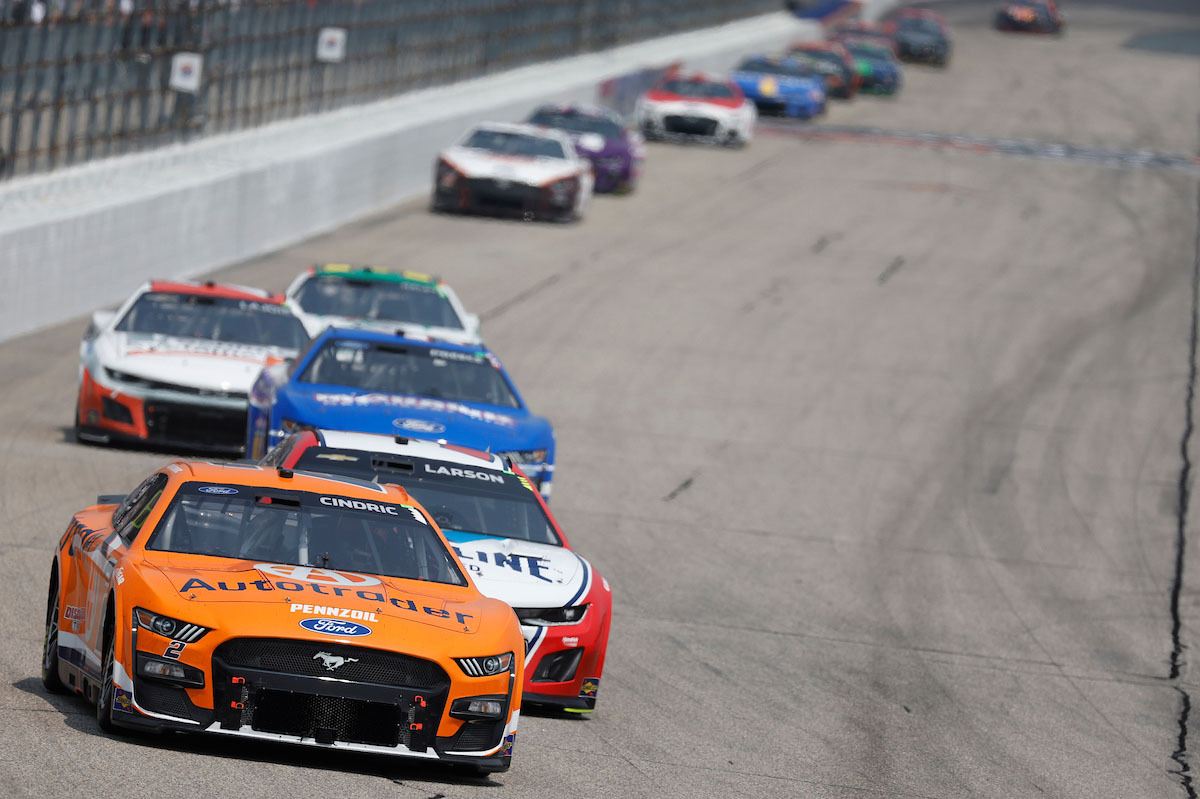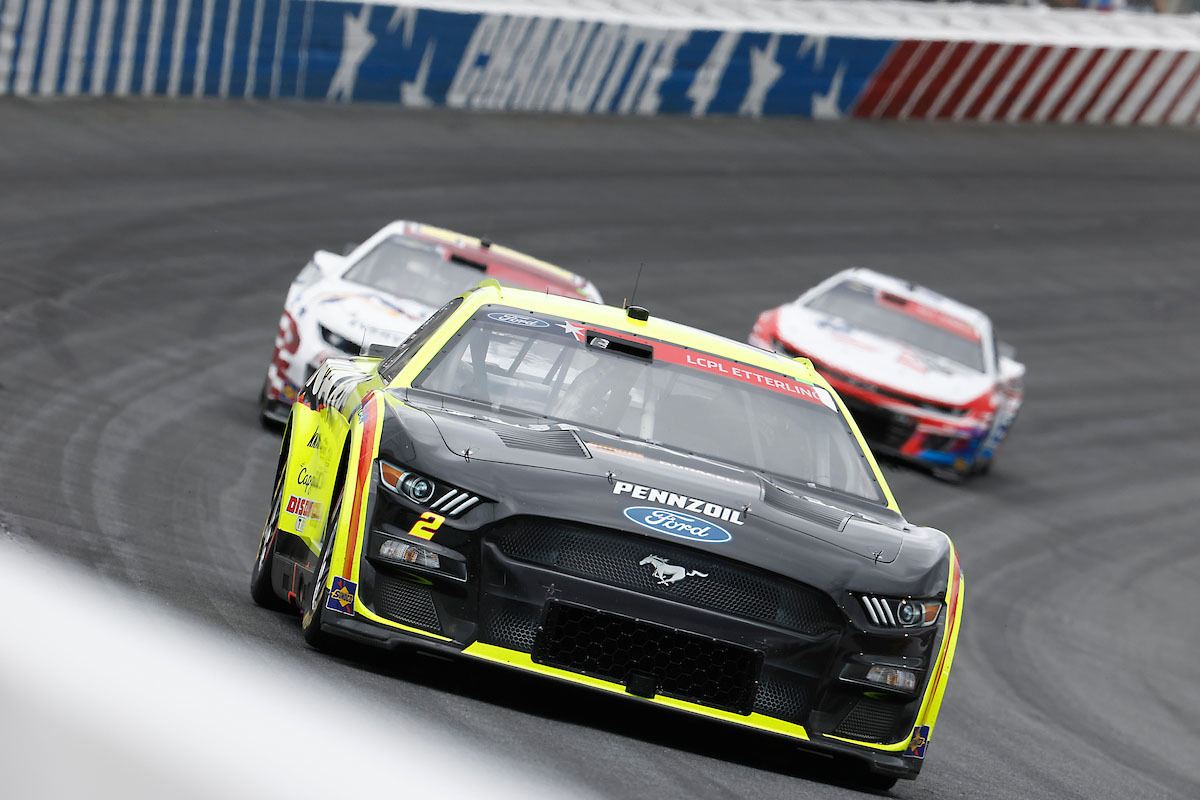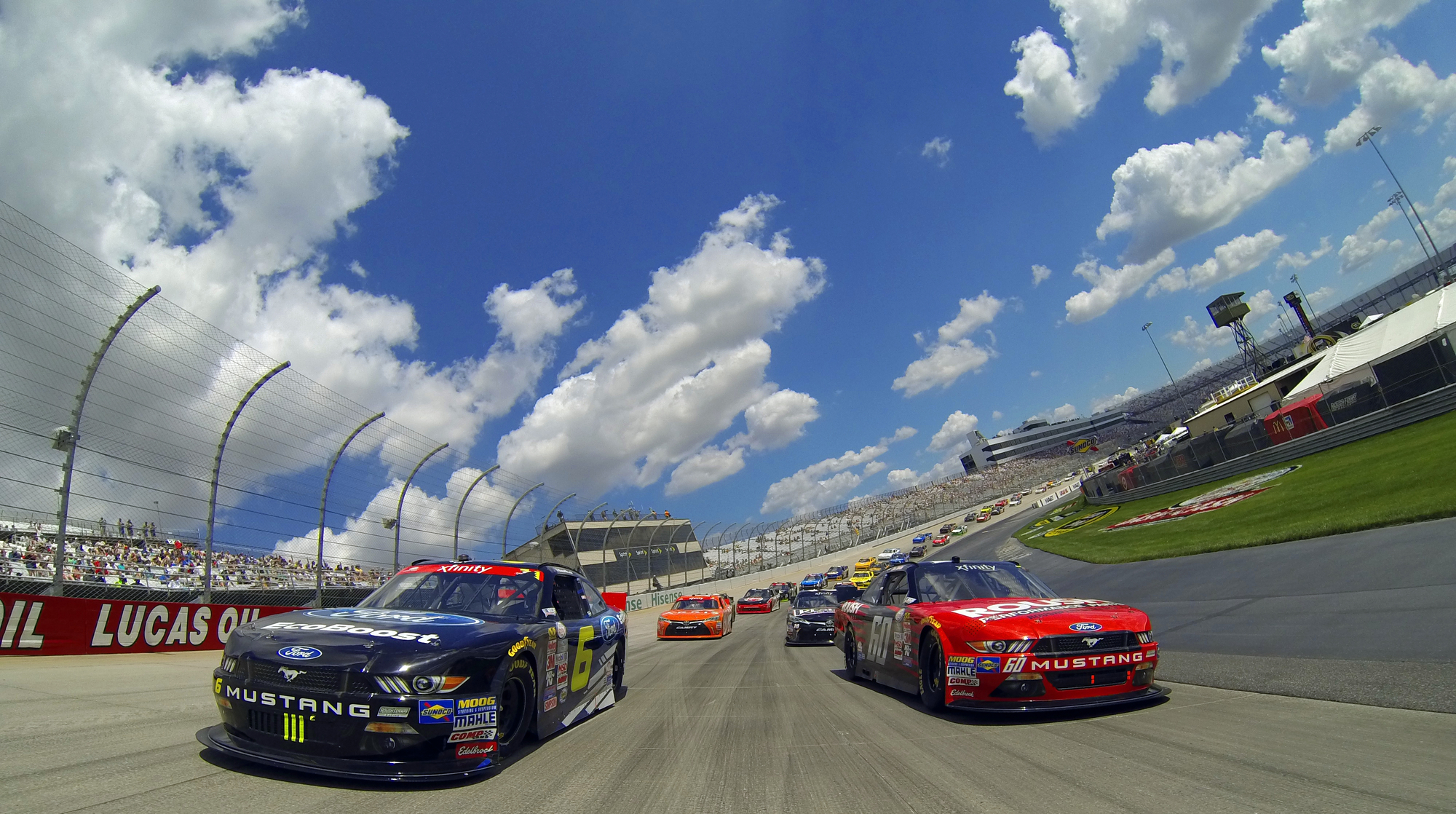How do NASCAR drivers talk to each other?
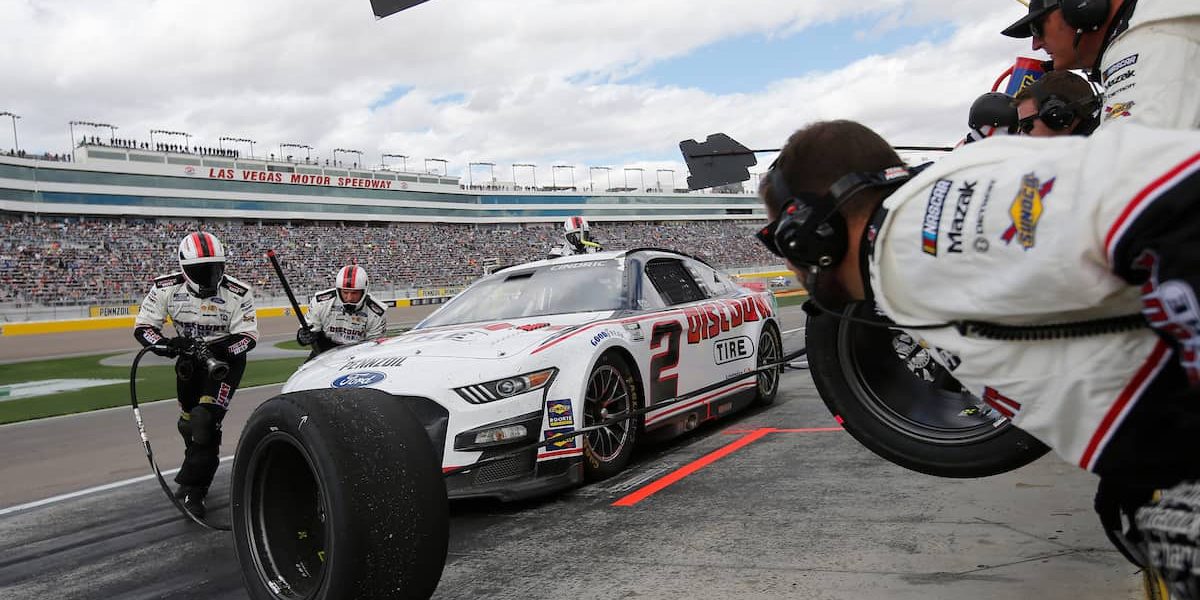
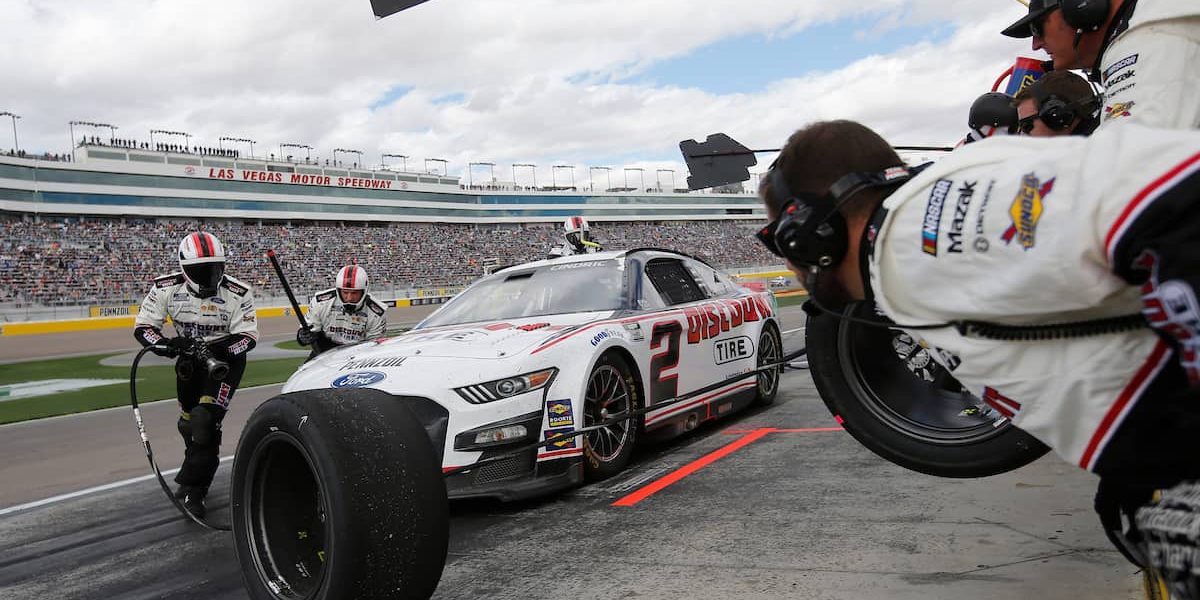
As the speed of NASCAR cars increases, the driver needs, and has to convey, a lot of information regarding track position, track safety conditions and performance of the car and strategy. This necessitates that the driver is in contact with their team, and race officials at all times. So how do NASCAR drivers talk to each other?
NASCAR now allows fans to have a radio to drop in on the chitchat on the track. That brings a lot of players in the loop of communication. The driver needs failproof communication with the spotter, crew chief, crew and race officials during the race.
The advent of two-way radios helped NASCAR and the teams to better coordinate their activities, performance and efficiency. NASCAR teams now communicate using radios. Two-way radios have proved to be a game-changer in the sport. A NASCAR event is probably the most challenging wireless audio event in the world. At a time, as many a 150,000 fans and 40,000 staff are packed within 3 to 4 square miles. Hundreds of radios are used and almost all radio frequencies are used for communication.
Table of Contents
How did communication evolve in NASCAR?
Race strategy is as important in NASCAR, as in any other race. The team plans when the driver will pit to refuel and change tyres. Pit stops consume precious seconds and the driver has to sacrifice his place when he pits and loses time. The plans may change mid-race depending on the circumstances. Race strategy is decided by the team manager, crew chief and team engineer along with the driver. The driver has to be in the know of developing events and any change in plans have to be communicated to him by the crew.
For a few decades following the launch of NASCAR races, teams used visual signs to communicate with the driver. There were a set of predetermined signals with which the driver would communicate with the crew. Match officials used flags to alert drivers of dangerous situations on the track. Communication with crew members and between race officials was at best rudimentary. That caused a lot of safety concerns both for the teams and NASCAR officials.
Teams used large “pit boards” with large fonts to indicate to the driver his position in the race. Information such as remaining laps and estimated fuel left in the fuel tank were also printed on pit boards. A team member would hold the pit board aloft for the driver to read as the car raced past the pit. The pit board would instruct the driver when he should pit for refuelling and a change of tyres.
Drivers would communicate with the team using hand signals as the car blurred past the pit. Reaching out and over the windshield and tapping the hood of the car would indicate that the driver wanted to pit. If there was a problem with the suspension, the driver would thump on the door panel. Communication was rudimentary and the driver could not convey any concerns he had about the car. That would be done only after the car came to a stop in the pit. Precious seconds would be spent in understanding and fixing the problem.
Many drivers have crashed or been a part of incidents when craning their neck to read the pit boards. That is where radio came to the rescue of NASCAR teams and officials. The events were better conducted and proceeded smoothly. Accidents and mishaps were reduced drastically. Radio was the turning point for NASCAR drawing more fans to the sport.
When was radio communication introduced in NASCAR?
The two-way radio revolutionised racing in NASCAR. Drivers could convey and discuss with the crew, the issues with the car. Team crews were better prepared to fix the problem when the driver pitted saving dear time. Wheel vibrations or lack of the engine’s response to the accelerator pedal could be reported and discussed with the crew. The team could be ready with the necessary tools and parts to solve the issue. Race strategies could be changed in a few seconds and every team member would be aware of the change. Race times started improving.
The first two-way radio was introduced in NASCAR in 1950. These were World War II surplus walkie talkies. Many teams considered the use of radios illegal while others thought their use was an unfair advantage to the team using them. After other teams protested, NASCAR banned the use of walkie talkies when racing. Many versions of radios were tried over the next twenty years but none were consistently used when racing.
More and more electronics was used in the cars themselves. Electronic radios were becoming more reliable by the mid-1970s. By then two-way radios had become a must use in NASCAR races. Team crews wearing headsets were seen in all the pits. In the 1990s miniaturised versions of earphones and microphones were developed. These were installed in the driver’s crash helmet. The radio itself was built into the car. Drivers could now communicate using hands-free radios.
What radios does NASCAR use?
Racing Radios, based in Forest Park, Atlanta, GA., is the official supplier of two-way radios for NASCAR. In the 1970s, NASCAR and Diversified Radios joined hands to develop radios used by racing teams, crews, drivers and race officials. Racing Radios, a unit of Diversified Radios, has supplied two-way radios to NASCAR for over 30 years. Racing Radio programs the frequencies for various players during an event. Different frequencies are used for teams and drivers, NASCAR officials, safety and security staff and others.
Most NASCAR teams and drivers buy their customised radio equipment. Crew radio equipment is tuned to specific needs. Some teams have shifted to using digital radio equipment. Many still use analogue radio systems while some teams use intercom systems in the pits. Motorola two-way radios are most used in NASCAR cars today. They are often carried in leather pouches. In the car, they are placed to the left of the driver. The driver can easily access the volume and channel selection knobs.
The driver’s crash helmet is fitted with a microphone and earpieces. The earpieces are custom designed for comfort. The driver can talk by pushing a push-to-talk switch on the steering wheel. A short whip antenna mounted on the roof of the car facilitates transmission and reception. As the microphone and the earpieces plug into the harness, Racing Radios’ wiring connects the two to the radio system. The radio system is powered by a small battery dedicated to the system. Background noise is reduced or cancelled by the Active Noise Reduction (ANR) technology used by Racing Radios.
Many chose to equip their entire pit and support crews with two-way radio systems. A team may have as many as 30 personnel supporting the driver. Teams with multiple car entries will have to outfit much more personnel with radios. Good communication technology helps teams refuel the car as well as change tyres in a mere 13 seconds. The crew may need to repeat the exercise eight to ten times during a race. As the event covers a large area and many people, repeaters are used to transmit both analogue and digital signals.
Who uses radios in a NASCAR event?
Team members, race officials, media and spectators all use radios during a NASCAR race. The driver is the key player in the whole show. Among the team members are the owner, team manager, crew chief, spotter, crew members, engineers, mechanics and others. Race officials need to inform the driver of hazardous conditions on the track ahead of him. Track safety officials do this by radio communication besides using flags when the situation demands.
Drivers
The driver’s field of vision is limited due to the safety headgear that he wears. He does not know his position in the race and who is creeping upon him. This information has to be conveyed to him by the team spotter. The driver needs to communicate with the crew chief about when to pit. The need to tell the chief about car performance, strategy and what to do when he pits keeps the driver in constant two-way communication with the chief.
The spotter mostly talks to the driver and the owner or team manager may intervene if they feel the need. The track race officials inform the driver when there is a caution on the track. The information on the number of laps remaining also comes from the officials whenever there is an update. Communication from the race officials is usually one way. Radio helps the driver keep in touch with the situation and convey his concerns to the crew.
Spotters
With the advent of good radios, teams were experimenting with the use of spotters since the 1980s. By the 1990s NASCAR recognised the role of spotters and began organising their positioning and eventually made spotters mandatory. Spotters are key players along with the drivers in a race. They keep the drivers informed of what is happening on the track. They are specially trained team members who watch out for their drivers and help them do well in races.
The spotter remains in constant radio contact with the driver. The spotter comes in handy for the driver whose peripheral vision is limited. The spotter is placed in a high structure or on top of the grandstands. He has the view of the whole track and informs the driver about accidents and race strategy. The spotter also informs the driver about his position and the position of his teammates. This helps drivers to work as a team and draft.
Being an eye in the sky, a spotter can see a car wreck much before a driver does. He tells the driver which is the best way to go around the wreck. Having a spotter in radio touch with the driver has helped NASCAR racing immensely by reducing pile-ups and improving race times. Spotters can also spot any sudden changes in the weather and alert the drivers and the crews.
Crew Chiefs
The crew chief is in charge of the whole team during a race. He needs to stay in touch with every occurrence during a race. As the crew chief decides on all important matters, he is constant with the driver, the spotter and the crew. He uses a two-way radio and can hear whatever conversation goes on within the team and outside it. He will intervene when necessary.
The driver constantly talks with the crew chief informing him about the car’s performance and discussing race strategy. The crew chief also gets to hear the one-way communication from the race officials. The two-way radio helps the crew chief stay in touch with every team member ensuring the team’s success in the race. In short, the radio makes the job of the crew chief much easier.
Crews
Every crew member is of equal importance in a NASCAR race. They are carefully chosen experienced persons in their assigned jobs. They keep the car at peak performance during the race. They make minor and major adjustments during pit stops. It is therefore important that all crew members are in touch with what happens to the car when racing. Crew members use a two-way hands-free radio as they wear helmets and their hands are always busy.
When the driver talks to the crew chief or the team engineer, the crew members listen in on their radios. They then make the necessary preparations to set right the concerns of the driver. If the driver wants a change of only two tyres or some adjustments to be done, the crew gets the necessary tools and spares ready. This saves on time spent in the pit and helps the driver stay in front. Two-way radios have greatly reduced pitting times.
Race officials and staff
At any NASCAR event, the activity of staff of 40,000 or more has to be planned and coordinated. Staff like the security staff track maintenance workers, race safety personnel ensure the safe conduct of the event. They need to be informed and to inform on the happenings at the venue. Different staff departments are assigned different radio frequencies and stay in contact with their senior officials through a two-way radio throughout the race. They communicate only when necessary to keep the radio channels open.
Media
The media plays an important role in broadcasting races to the millions of fans watching from their couches. Although media broadcasts are a one-way affair, their staff has to stay in touch with each other. Media is entitled to be updated by the second of what is happening on the track and outside it. Their staff has to know who their colleague is interviewing and who is up next. They stay in touch with each other and other reporters by two-way radios. This helps the media bring real-time information to NASCAR fans outside the venue.
Fans
Fans are the sole reason any sport exists and prospers and so is the case with NASCAR. In any given NASCAR event, tens of thousands of fans listen to the conversations in the arena using a two-way radio. All the communication within teams is transmitted to nascar.com. Fans have to only download an app and then eavesdrop on their favourite teams’ conversations. By doing so, fans can get emotionally involved with the sport. Fans also use two-way radios to converse among themselves. Radios help enhance fans’ experiences at races and have attracted more fans to NASCAR.
How do NASCAR drivers talk to each other? – Conclusion
Two-way radio has revolutionised how NASCAR events are organised and conducted. Radio has increased safety during races and enhanced the efficiency of the system. Being an extremely dense radio wave atmosphere, Racing Radios does a good job by providing clean transmission and reception. Continual research and development go on to increase the quality of radio reception. Radio is the best thing that has happened to NASCAR teams, race officials, media and NASCAR fans.






